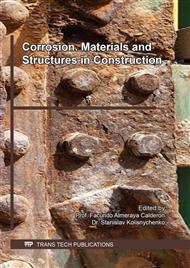[1]
A.A. Kuznetsov, A.S. Bryukhova, N.V. Volkova, Testing of comparison samples to determine corrosion products on the surface of reinforced concrete products. The collection of theses of reports of X International scientific-technical conference Polytransport system,, Novosibirsk, 2018, p.267.
Google Scholar
[2]
A.A. Kuznetsov, A.S. Bryukhova, Determination of the quantitative content of corrosion products on the surface of reinforced concrete products, Journal Omsk Scientific Bulletin, Omsk. 6 (152) (2018) 160-164.
DOI: 10.25206/1813-8225-2018-162-160-164
Google Scholar
[3]
V. Borovikov, STATISTICA, The art of data analysis on a computer: For professionals, Saint-Petersburg, Piter Publ., 2003, 688 p.
Google Scholar
[4]
E.S. Venttsel, L.A. Ovcharov, Probability theory and its engineering applications, Moscow. «Vysshaia shkola» [Higher school] Publ., 2007, 491 p.
Google Scholar
[5]
V.E. Gmurman, Probability theory and mathematical statistics, Moscow, «Vysshaia shkola» [Higher school] Publ., 2003, 479 p.
Google Scholar
[6]
D.J. Finney, An Introduction to the Theory of Experimental Design, Chicago, University of Chicago Press Publ., 1960, 223 p. Russ. ed.: Finni D. Introduction to the theory of experiment planning, Moscow. «Nauka» [Science] GRFML [main edition of physical and mathematical literature] Publ., 1970, 288 p.
Google Scholar
[7]
K.H. Shenk, Theory of engineering experiment, Moscow. «Мир» [World] Publ., 1972, 382 p.
Google Scholar
[8]
Yu.P. Adler, Introduction to design of experiments, Moscow. «Metallurgiia» [Metallurgy] Publ., 1968, 155 p.
Google Scholar
[9]
G. Box, J. Hunter, Multi-Factor Experimental Designs for Exploring Response Surfaces, The Annals of Mathematical Statistics, vol. 28, no. 1, 1957, pp.195-241.
DOI: 10.1214/aoms/1177707047
Google Scholar
[10]
S. Shliuker, Surface-enhanced Raman spectroscopy (SERS): analytical, biophysical and biomedical applications, Moscow. «Tekhnosfera» [Technosphere] Publ., 2017, 331 p.
Google Scholar
[11]
A.T. Labutin, A.M. Popov, S.M. Zaytsev, N.B. Zorov, M.V. Belkov, V.V. Kiris, S.N. Raikov, Determination of chlorine, sulfur and carbon in reinforced concrete structures by double-pulse laser-induced breakdown spectroscopy, Spec-trochimica Acta Part B. 99 (2014) 94–100.
DOI: 10.1016/j.sab.2014.06.021
Google Scholar



